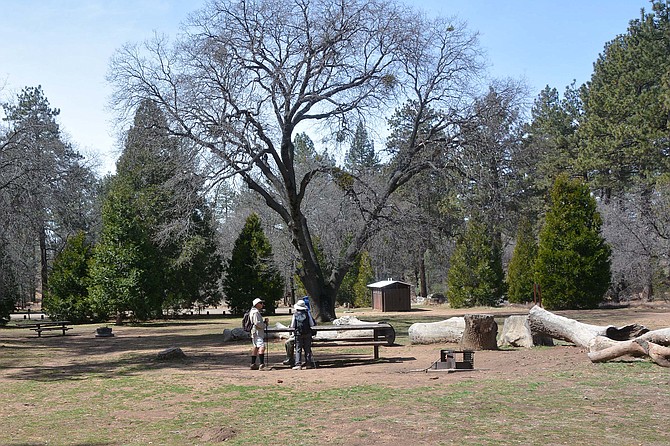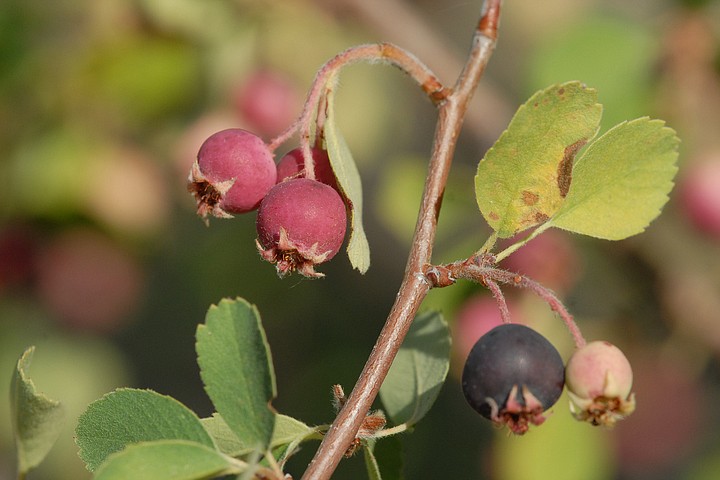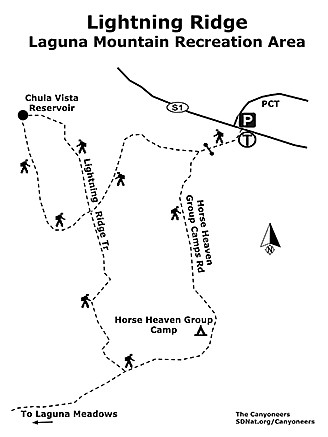 Facebook
Facebook
 X
X
 Instagram
Instagram
 TikTok
TikTok
 Youtube
Youtube

Lightning Ridge Trail is accessible and enjoyable during all seasons, but especially beautiful in the spring and summer, when flowers and shrubs are blooming. This is a good time to hike this trail, especially with the rain that we have had this year. Particularly delightful are the ceanothus, manzanita, and chokecherry. Pine, cedar, and oak trees shade the trail as it winds upwards through the forest.
The trail is a little uneven where it is covered with small rocks; otherwise, the ground is soft forest debris. About a half mile up the road from the trailhead, you will see the trail where it crosses the rocky road. Turn to the right and take the small trail up the gently-sloping hillside. Be aware of your surroundings and watch for snakes.

From this beautiful narrow trail, you will begin to get glimpses of the adjacent hillside and of the mountains in the distance. As you climb, you will notice that there are fewer trees but more shrubs and flowers, such as lupine, sunflowers, and mallow. You will know that you have reached the top of the ridge when you see the very large water tank. This is the Chula Vista Reservoir, which is the water source for that city.
From the top of the ridge, you can enjoy wonderful views of the surrounding peaks, the Laguna Meadows and the desert to the east. On the way down, you will have views of the Little Laguna Meadow and the Laguna Campground. When you reach the rocky road that you left when you reached the trail on your way up, you have a choice of either going back the same way or staying on the trail and enjoying a visit to three small group camp sites, called Lupine, Hollyhock and Buttercup, which are part of Horse Heaven Group Campground. Despite the name, this is not a horse camp. The Cleveland National Forest campsites have vault toilets, water, and campfire circles. It is designed for groups of 40, 70, or 100 people who want to stay at the sites, which are surrounded by a pine forest.
In this setting, one could imagine native peoples sitting in groups under the trees preparing food: the Kumeyaay and their ancestors traveled through the Laguna Mountains on their annual journey from the ocean to the desert and back, and there are many pre-historic archaeological sites and artifacts throughout the Laguna Mountains: grinding rocks, pottery shards, and flakes. Remember, all artifacts are legally protected—you must leave them where you find them. The Native Americans were able to feed and clothe themselves using only the plants, animals, and rocks around them.
Major food crops harvested by the Kumeyaay in years past in this area included acorns from oaks and pine nuts from pine trees. They also harvested manzanita berries, chokecherries, and the corms of wild hyacinth/blue dicks/school bells (Dichelostemma capitatum).
Once a year, the Laguna Mountain Volunteer Association presents the history of the peoples of Mt. Laguna, both the original peoples and those who arrived more recently. If you participate in one of the presentations about the Kumeyaay people, you will discover why these hunter-gatherers called these mountains a land of plenty.
By following the loop around these three group camp sites, you will find yourself back on the rocky road that you left earlier. If you follow this road east, you will find your way back to the highway and the parking area. On the way down from the mountain, you might wish to stop for a snack or ice cream at the Laguna General Store, which is just past the Ranger Station.

LIGHTNING RIDGE—LAGUNA MOUNTAIN RECREATION AREA
Enjoy amazing views of the mountains and desert.


Lightning Ridge Trail is accessible and enjoyable during all seasons, but especially beautiful in the spring and summer, when flowers and shrubs are blooming. This is a good time to hike this trail, especially with the rain that we have had this year. Particularly delightful are the ceanothus, manzanita, and chokecherry. Pine, cedar, and oak trees shade the trail as it winds upwards through the forest.
The trail is a little uneven where it is covered with small rocks; otherwise, the ground is soft forest debris. About a half mile up the road from the trailhead, you will see the trail where it crosses the rocky road. Turn to the right and take the small trail up the gently-sloping hillside. Be aware of your surroundings and watch for snakes.

From this beautiful narrow trail, you will begin to get glimpses of the adjacent hillside and of the mountains in the distance. As you climb, you will notice that there are fewer trees but more shrubs and flowers, such as lupine, sunflowers, and mallow. You will know that you have reached the top of the ridge when you see the very large water tank. This is the Chula Vista Reservoir, which is the water source for that city.
From the top of the ridge, you can enjoy wonderful views of the surrounding peaks, the Laguna Meadows and the desert to the east. On the way down, you will have views of the Little Laguna Meadow and the Laguna Campground. When you reach the rocky road that you left when you reached the trail on your way up, you have a choice of either going back the same way or staying on the trail and enjoying a visit to three small group camp sites, called Lupine, Hollyhock and Buttercup, which are part of Horse Heaven Group Campground. Despite the name, this is not a horse camp. The Cleveland National Forest campsites have vault toilets, water, and campfire circles. It is designed for groups of 40, 70, or 100 people who want to stay at the sites, which are surrounded by a pine forest.
In this setting, one could imagine native peoples sitting in groups under the trees preparing food: the Kumeyaay and their ancestors traveled through the Laguna Mountains on their annual journey from the ocean to the desert and back, and there are many pre-historic archaeological sites and artifacts throughout the Laguna Mountains: grinding rocks, pottery shards, and flakes. Remember, all artifacts are legally protected—you must leave them where you find them. The Native Americans were able to feed and clothe themselves using only the plants, animals, and rocks around them.
Major food crops harvested by the Kumeyaay in years past in this area included acorns from oaks and pine nuts from pine trees. They also harvested manzanita berries, chokecherries, and the corms of wild hyacinth/blue dicks/school bells (Dichelostemma capitatum).
Once a year, the Laguna Mountain Volunteer Association presents the history of the peoples of Mt. Laguna, both the original peoples and those who arrived more recently. If you participate in one of the presentations about the Kumeyaay people, you will discover why these hunter-gatherers called these mountains a land of plenty.
By following the loop around these three group camp sites, you will find yourself back on the rocky road that you left earlier. If you follow this road east, you will find your way back to the highway and the parking area. On the way down from the mountain, you might wish to stop for a snack or ice cream at the Laguna General Store, which is just past the Ranger Station.

LIGHTNING RIDGE—LAGUNA MOUNTAIN RECREATION AREA
Enjoy amazing views of the mountains and desert.